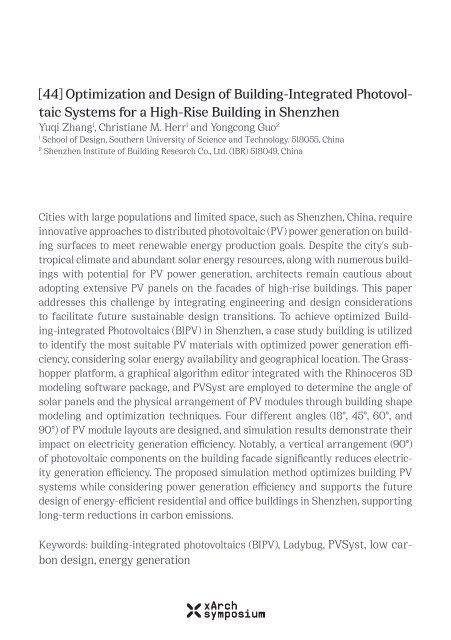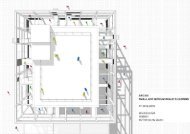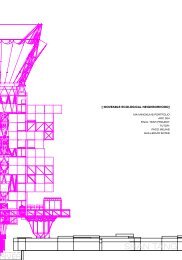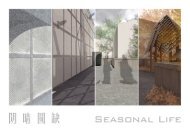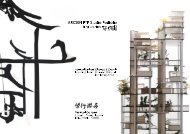231108_GDM_xArch_preprints
You also want an ePaper? Increase the reach of your titles
YUMPU automatically turns print PDFs into web optimized ePapers that Google loves.
[44] Optimization and Design of Building-Integrated Photovoltaic<br />
Systems for a High-Rise Building in Shenzhen<br />
Yuqi Zhang 1 , Christiane M. Herr 1 and Yongcong Guo 2<br />
1<br />
School of Design, Southern University of Science and Technology. 518055, China<br />
2<br />
Shenzhen Institute of Building Research Co., Ltd. (IBR) 518049, China<br />
Cities with large populations and limited space, such as Shenzhen, China, require<br />
innovative approaches to distributed photovoltaic (PV) power generation on building<br />
surfaces to meet renewable energy production goals. Despite the city's subtropical<br />
climate and abundant solar energy resources, along with numerous buildings<br />
with potential for PV power generation, architects remain cautious about<br />
adopting extensive PV panels on the facades of high-rise buildings. This paper<br />
addresses this challenge by integrating engineering and design considerations<br />
to facilitate future sustainable design transitions. To achieve optimized Building-integrated<br />
Photovoltaics (BIPV) in Shenzhen, a case study building is utilized<br />
to identify the most suitable PV materials with optimized power generation efficiency,<br />
considering solar energy availability and geographical location. The Grasshopper<br />
platform, a graphical algorithm editor integrated with the Rhinoceros 3D<br />
modeling software package, and PVSyst are employed to determine the angle of<br />
solar panels and the physical arrangement of PV modules through building shape<br />
modeling and optimization techniques. Four different angles (18°, 45°, 60°, and<br />
90°) of PV module layouts are designed, and simulation results demonstrate their<br />
impact on electricity generation efficiency. Notably, a vertical arrangement (90°)<br />
of photovoltaic components on the building facade significantly reduces electricity<br />
generation efficiency. The proposed simulation method optimizes building PV<br />
systems while considering power generation efficiency and supports the future<br />
design of energy-efficient residential and office buildings in Shenzhen, supporting<br />
long-term reductions in carbon emissions.<br />
Keywords: building-integrated photovoltaics (BIPV), Ladybug, PVSyst, low carbon<br />
design, energy generation


